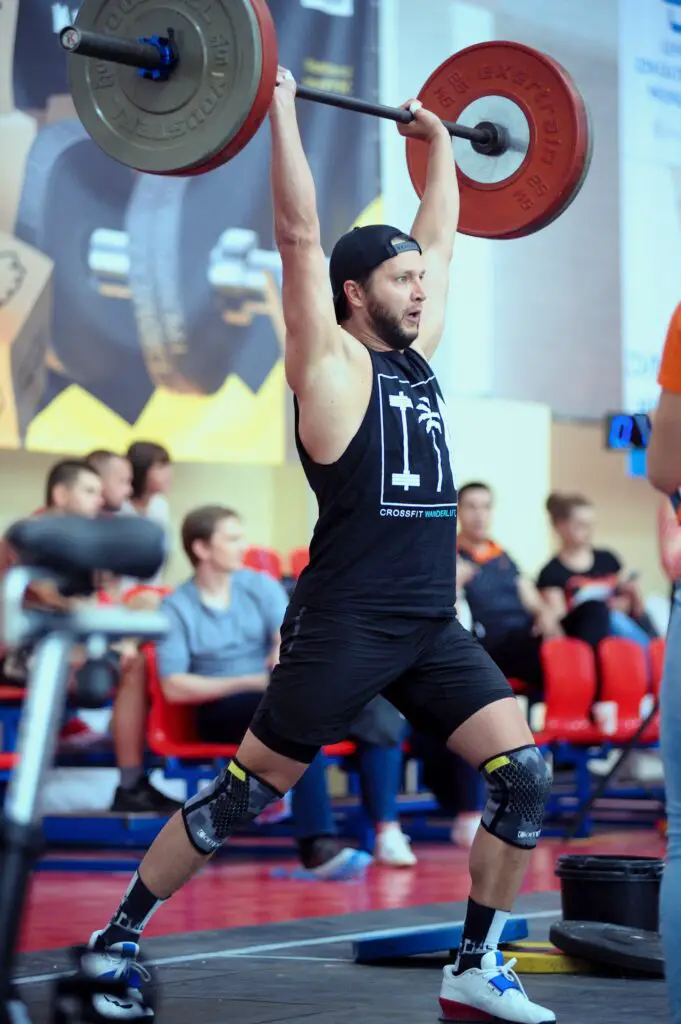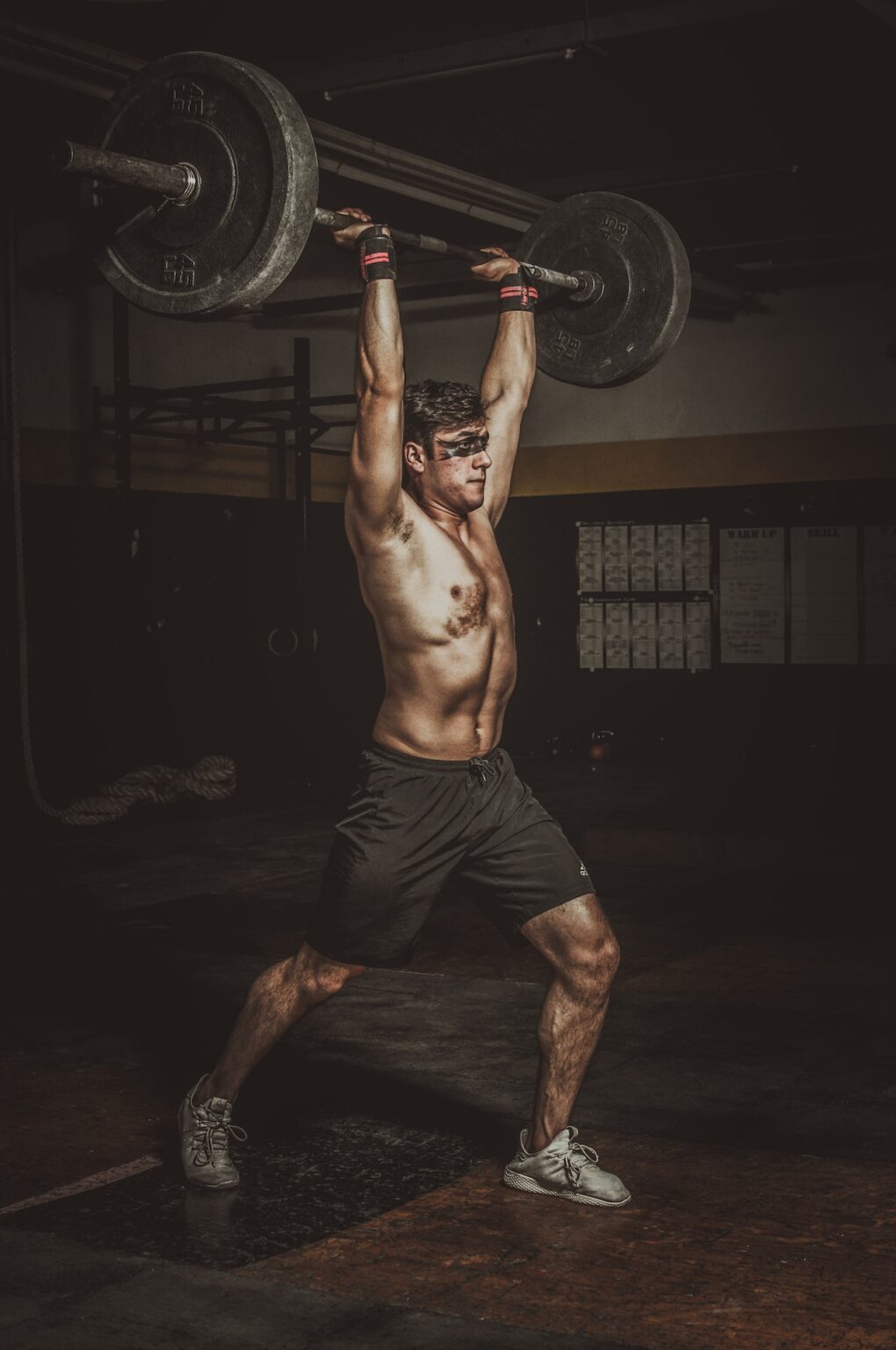The Push Jerk is the last part of an Olympic lift called the Clean and Jerk. It looks complicated, but it is actually pretty natural. I can even show you how you’ve done it several times in your daily life.
The Two Olympic Lifts and Their Purpose
The purpose of Olympic weightlifting is to get the bar from the ground to over your head. There are two methods of which to do this:
- Clean and Jerk
- Snatch
This article will cover the Clean and Jerk, but we will look more specifically at the jerk (also called a push jerk). Here’s a short clip on what it looks like:
If you’ve ever watched Olympic weightlifting on television, you’ll notice that the Olympian’s feet are usually split at the bottom like in this picture:

This is what is called a “Split Jerk.” The only difference is that you can go a little lower (and lift a bit heavier) than with your feet next to each other like in the video.
Now, whether we call it a Jerk, Push Jerk, or Split Jerk, they all refer to the method of getting the weight from your shoulders to over your head.
The Concept of Olympic Weightlifting
It is a bit hard for people to understand the difference between regular resistance training and Olympic weightlifting. Here’s the difference: Olympic weightlifting has a goal of lifting the maximum amount of weight. Resistance training has a goal of training your muscles.
They have two very different purposes.
When you’re practicing resistance training in the gym, you aren’t supposed to “cheat.” Sometimes you’ll see people swinging their hips, arching their backs and doing all sorts of goofing things to get that weight up. Then a trainer will jump in and “correct” their form so that the intended muscle gets trained.
When you’re practicing Olympic weightlifting, the purpose is to cheat. Lift the bar up as far as you can and then sneak under it and finish the lifting with your legs. Use the big muscles to do the work.
The Push Jerk is divided up into two parts:
- Push – the part of the movement when the bar goes up
- Jerk – the part of the movement when you sneak under the bar to lock your elbows.
- Okay, there’s the third part where you straighten your legs. All the fun is really in the first two.
Olympic Weightlifting Is Natural
Have you ever been struggling to lift something up into your truck or up above your head?
You heave it up to a certain point and then squat down a bit so you can grab it at a different angle and finish it out.
That’s all that’s really happening with Olympic weightlifting. Since the goal is painfully simple – to lift as much weight overhead as possible – you pull it up as high as you can, sneak under it and finish it out with your legs.
Proper Techniques of Lifting
Now, in order to perform these moves safely, you need some training. There is a proper way to do this (meaning the way you won’t hurt yourself) and many improper (injurious) ways.
What’s interesting is that if you lift with perfect form, you will keep from injuring yourself and you will lift the most weight.
There are coaches trained in the Olympic lifts and you should make sure that they are reputable and certified before you start putting up heavy weight.
When Olympic Weightlifting Hit the Mainstream
This has always been known as a higher-level activity that would be relegated to people wearing tights, slapping chalk on their hands and screaming loud.
Without question, Olympic weightlifting hit the mainstream when CrossFit entered the scene. Sometimes there’s screaming. Sometimes there’s chalk. Sometimes there’s tights. But the scene varies widely and rarely are all three of these present in your typical CrossFit gym.
Most of the classic gym chains still aren’t set up for Olympic weightlifting, though.
Probably because you’ve got to have a qualified, competent trainer supervising new people. And because it is loud. And because the risk for injury is higher than lifting a 20-pound dumbbell.
If you’ve never been to a CrossFit gym, then you probably don’t think that Olympic weightlifting has hit the mainstream. Just give it another decade and you’ll see more and more gyms offering a space for this.
Olympic Weightlifting Is Fun!
I must say – over and over – that these lifts are really, really fun.
There is an initial period where you are getting used to the weird positions, testing your shoulder flexibility and learning how to catch something in a deep squat. It is awkward. It is uncomfortable. And it can be slightly demoralizing. But this is no different than learning any other skill.
You start at the beginning.
But then you start to nail a few moves. It’s not just your coach that lights up, the move feels right. It just snaps into place and you realized you lifted 135 pounds, 185 pounds, and more and more.
You begin to look at things like pinball machines and Mini Coopers and you almost want to give it a try…
Your spouse doesn’t just become the one you love, but the one you throw over your shoulders to add some weight to your squat routine.
In short, your environment becomes that much less threatening. And you become that much more threatening to your environment.
Variations
You don’t need a barbell with bumper plates in order to learn the basics of Olympic weightlifting. CrossFit teaches them with a relatively soft medicine ball. You could do dumbbell push jerks. You can do push jerks with kettlebells. There isn’t any CrossFit push jerk or some signature variation. Just learn the basic moves.
Talk to an experienced coach to see all of the variations and what would be a good start for you.
I’ve found that when someone’s been training with a medicine ball, dumbbells, kettlebells and has seen others do the movement – they get it. A big part of these moves is understanding the concept and the feel of them.
After that, it’s just fixing little points of form.
Who Can Learn the Olympic Lifts?
Absolutely everyone.
I’ve trained kids and the elderly and everyone in between. I’ve taken in-depth courses on the subject. I’ve studied it in a college setting – theory and practical. I’ve gotten certified to teach them.
Only then can you teach them to the kids and elderly. And you’ve got to be careful not to use much weight on either. And you’ve got to know everything about their medical history that you can so you don’t injure them. Don’t try teaching these moves unless you’re qualified to one degree or another.
But, when done safely, these moves are for everyone.
Learning How To Bail
One of the most fun things is teaching someone to drop the bar on a failed move.
It is quite a noisy affair to have a barbell drop on the ground. Lots of people will try to get under the bar to keep it from hitting too hard. But in Olympic weightlifting, that is the last thing you want to do. You’ve got to do whatever you can to get away from that bar before it hits the ground.
So when I see someone scared to make a noise, I’ll have them hold an empty bar above their head and step back and drop it. We do this over and over until they can comfortably bail out of a move with no attention on the noise the bar is going to make.
This is Step Zero. An often overlooked step in training the Olympic lifts to the average man or woman.
You’ve got to teach people the proper way to bail out of the movement or they are liable to hurt themselves.
Conclusion
Training the Push Jerk is one part of learning the Olympic lifts.
You’ve got to be comfortable with the Clean and the Push Jerk to do the full Clean & Jerk.
A good coach for these moves is worth his weight in gold.
Here’s the Clean & Jerk in full:


